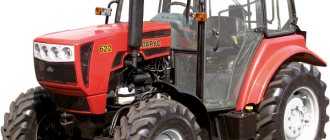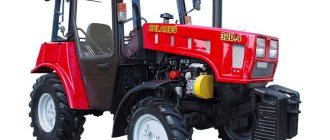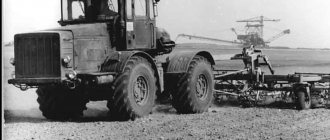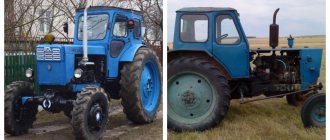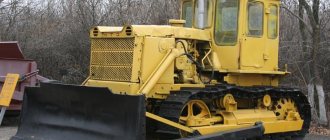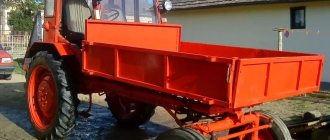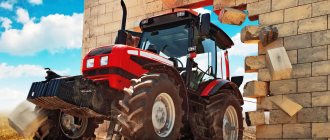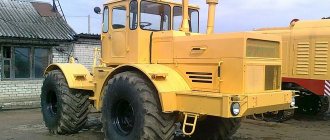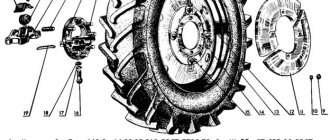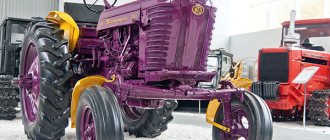Tractor YuMZ-6
The unit was developed at the Southern Machine-Building Plant (Ukraine, Dnepropetrovsk) on the basis of the MTZ-5 tractor. This plant in the past worked for the defense industry, and its products (including tractors) were famous for their high reliability. Military acceptance rules were strict. The YuMZ-6 model turned out to be successful, and after 2 years the company had already produced one hundred thousand copies.
The layout of the tractor is classic, with a semi-frame on which the front axle and a four-stroke diesel engine are located. The cabin is located at the rear of the unit.
Purpose
The tractor is adapted to work in a wide temperature range. It starts perfectly in forty-degree frost (maximum temperature) and can withstand heat up to plus forty. In addition to general agricultural work, it is used in production, construction, public works, and also as a vehicle. Attaching a variety of mounted and trailed equipment increases the capabilities of the tractor.
Photo of the YuMZ-6 tractor
The device is often used as a drive for portable and stationary equipment. Equipped with a trailer, it can transport various loads. And if you equip it with a bulldozer blade or excavator bucket, you can use the machine in the construction and repair of roads.
Pros and cons of the model
Advantages:
- High reliability and good quality of all components.
- Quiet and smooth running of the economical engine, it has a decompressor, quick start even in cold weather.
- The engine can be easily removed for repair and maintenance.
- Strong rear hubs and axle shafts, excellent locking.
- Simplicity of design and availability of spare parts.
Disadvantages (according to owners):
- Rigid chassis.
- Not very high engine speed.
- The motor is not suitable for long-term operation with no load (it cokes).
Front axle of the YuMZ tractor
The front axle of the YuMZ tractor is a swinging cast tubular beam with split ends. The beam, with its tides, is connected through the swing axis to the eyes of the front beam of the tractor frame. The swing axis is secured against axial movements and rotation in the front beam with a wedge-shaped bolt. At both ends, retractable fists are inserted into the beam, consisting of a bracket and a pipe welded together.
The pipe has six holes at 50 mm intervals for the clamp. This makes it possible to obtain six positions of the retractable cam in the main pipe. Each of these positions corresponds to a specific track of the guide wheels. The pipe is clamped in the beam with coupling bolts.
In the bracket of the retractable knuckle, a rotary axle is installed on two bushings and a thrust ball bearing, into which the front wheel axle shaft is pressed. The cavity of the bushings and bearing is sealed at the bottom with two rubber rings, and at the top with a rubber ring and a felt seal. On the upper ends of the swivel axles of the YuMZ front axle, swivel arms are mounted on splines and secured with coupling bolts. The levers are pivotally connected through transverse and push rods to a central lever mounted on the steering lever, connected through a longitudinal rod to the steering. The length of the transverse and push rods is adjustable, which is necessary when changing the track and adjusting the toe-in of the guide wheels. The steering lever rotates on two bronze bushings mounted in the boss of the beam. In the upper part, the lever shaft is sealed with a rubber seal, and in the lower part with a felt seal.
Front axle of the YuMZ tractor: 1 - bracket; 2 and 27 — rotary levers; 3 - pipe; 4 — clamp; 5 - bolt; 6 - beam; 7 — swing axis; 8 - tide; 9 — steering lever; 10, 19 and 22 - oilers; 11—longitudinal thrust; 12 - spring; 13 - rubber coupling; 14 — liner; 15 — overlay; 16 — adjusting plug; 17 — ball pin; 18 — emphasis; 20 - oil seal; 21 and 24 — rubber rings; 23 - ball bearing; 25 — axle shaft; 26 — rotary axle; 28 — hinge plug; 29 — lower liner; 30 — ball joint pin; 31 — upper liner; 32 — sealing cover; 33 — push rod; 34 — central lever; 35 — tip hinge; 36 - transverse thrust.
The angle of rotation of the guide wheels of the YuMZ front axle is limited by the angle of rotation of the steering lever, which, when turning, rests against the boss on the axle beam. The designs of the joints of the transverse and push rod ends are the same. The ball joint pin rotates in two liners: the upper one made of polyamide and the lower one made of rubber. The liners are pressed against the head of the pin by an adjusting plug, wrapped in the tip body and held from unscrewing by a cotter wire. The hinge is lubricated with lubricant placed into it during assembly. The hinge is protected from dust and water by a rubber sealing cover.
Device
Engine
The diesel engine of one of two models (60 or 62 horsepower) with four cylinders arranged in a row is not turbocharged. To start it, either a starting motor or an electric starter can be used (this depended on the engine version).
Transmission
The transmission type of this model is mechanical, with nine speeds. To control the unit drive gearbox and the gearbox (five-speed, with movable gears), one lever is used. The steering column can be adjusted both in height (infinitely variable) and by rotating it (there are four fixed positions). The steering wheel is controlled using a hydraulic booster.
Chassis
The wheels located at the rear are controlled by a rigid suspension with a mechanical differential lock. The front wheels (through which the turn is carried out) have a portal rigid suspension. Braking is performed by dry disc brakes. The track of the rear wheels changes smoothly. On the rear wall of the gearbox and rear axle there is a special bracket designed to secure attachments in front of the tractor (front hitch). Transmission diagram of the YuMZ-6 tractor
1 – primary shaft; 2 – coupling bolt; 3 – drive gear; 4 – pressure plates; 5, 31 – glasses; 6 – intermediate roller; 7 – adjusting gasket; 8 – ball bearing; 9 – gear for engaging second and fourth gears; 10 – gear shift rollers; 11 – shift roller clamp; 12 – locking roller; 13 – locking roller lock; 14 – traction; 15 – drawstring; 16 – switch; 17 – emphasis; 18 – axis; 19 – lever for engaging the PTO drive clutch lock; 20 – rocking chair; 21 – spring-loaded latch; 22 – stand; 23 – gear shift lever; 24 – bolt; 25 – gear shift column housing; 26 – fork; 27 – lever stop; 28 – gear for engaging first gear and reverse gear; 29 – secondary shaft; 30 – roller bearing; 32 – gear for engaging third and fifth gears; 33 – round nut; 34 – reverse drive gear; 35 – drive gear of the first gear; 36 – third gear drive gear; 37 – intermediate shaft; 38 – drive gear of fourth and fifth gears; 39 – drive gear of the second gear; 40 – thrust ring; 41 – oil drain plug; 42 – constant mesh gear; 43 – gearbox housing; 44 – PTO drive shaft.
Rear axle of the YuMZ tractor. Repair and adjustment
The rear axle of the YuMZ tractor , and in particular the differential, ensures rotation of the drive wheels at different frequencies when the tractor moves around turns and on uneven surfaces.
The differential of the rear axle of the tractor is gear, open type, with two satellites, which are bevel gears with straight teeth. The satellites with bronze bushings pressed into them are placed in special windows in the hub and can rotate freely on fixed axles secured with bolts. The satellites are in constant mesh with the semi-axial gears, each of which is made as one piece with the final drive drive gear and rotates on two cylindrical roller bearings installed in cups independently of the main gear shaft. The threaded holes in the satellite axles are intended for pressing them out of the differential hub when disassembling the rear axle of the YuMZ tractor.
Diagram of the rear axle of the YuMZ tractor: 1 - drive gear; 2 - semi-axial gear; 3 — satellite; 4 — support washer; 5 — satellite axis; 6 and 22 - bolts; 7 and 21 - driven gears; 8 — pedal of the differential lock mechanism; 9 — PTO engagement lever; 10 - spring; 11 — breather; 12 - fork; 13 - coupling; 14 — roller; 15 — brake gear; 16 — brake; 17 - cover; 18 and 25 - ball bearings; 19 — axle shaft; 20 — axle sleeve; 23 — power take-off shaft; 24 — PTO clutch; 26 — roller bearing; 27 — adjusting shims; 28 - glass; 29 — main gear shaft; 30 - hub.
While the tractor is moving, the rotation of the drive gear of the secondary shaft of the gearbox is transmitted to the driven gear. Together with the driven gear and hub, the axles with satellites mounted on them also rotate. When the tractor moves in a straight line, when both drive wheels experience the same resistance, the entire differential system rotates as one.
The satellites are like wedges that connect both semi-axial gears into one whole axis; The tractor wheels rotate at the same frequency, corresponding to the gear rotation speed.
When the tractor turns, one of the side gears, due to the increase in resistance of the wheel located closer to the center of the turn, slows down the rotation compared to the gear. The satellite teeth rest against the teeth of the semi-axial gear that has slowed down the rotation and begin to rotate around their axes; at the same time, they force the other side gear to speed up its rotation compared to the gear exactly as much as the rotation of the first side gear has slowed down.
Specifications
Technical characteristics of the YuMZ-6 tractor:
| Characteristics | Indicators | Unit measurements |
| engine's type | D-65 or D-242-71 | |
| Forward operating speed (maximum) | 11,1 | km/h |
| Forward transport speed (maximum) | 24,5 | km/h |
| Reverse speed (maximum) | 5,7 | km/h |
| Turning radius | 5 | m |
| For the D-65 engine: | ||
| - engine power | 45,6 | kW |
| — rotation speed (nominal) | 1750 | rpm |
| — torque (maximum) | 270 | N*m |
| - cylinder diameter | 11 | cm |
| — piston stroke | 13 | cm |
| - fuel consumption | 245 | g/kWh |
| — working volume | 4,94 | l |
| For engine D-242-71: | ||
| - engine power | 46 | kW |
| - rotation frequency | 1800 | rpm |
| — torque (maximum) | 241 | N*m |
| - cylinder diameter | 11 | cm |
| — piston stroke | 12,5 | cm |
| - fuel consumption | 226 | g/kWh |
| — working volume | 4,75 | l |
| General characteristics: | ||
| — number of engine cylinders | 4 | PC. |
| — volume of the fuel tank | 90 | l |
| — forward operating speed (maximum) | 11,1 | km/h |
| — forward transport speed (maximum) | 24,5 | km/h |
| — reverse speed (maximum) | 5,7 | km/h |
| — turning radius | 5 | m |
| - front track size | 1,36-1,86 | m |
| - rear track size | 1,4-1,8 | m |
| - wheelbase | 2,45 | m |
| — clearance (under the front axle) | 0,45 | m |
| — clearance (under the rear axle) | 0,645 | m |
| — weight (operational, with additional loads) | 3,895 | T |
| — tractor weight | 2,895 | T |
| — weight (structural, with working equipment) | 3,35 | T |
| — permissible trailer weight | 6 | T |
| - width | 1,884 | m |
| — height (in the cabin) | 2,66 | m |
| — height (at muffler) | 2,86 | m |
| — length (with hanging system) | 4,14 | m |
| — length (without hanging system) | 3,69 | m |
Technical characteristics of the YuMZ 6 tractor
YuMZ-6 is a classic wheeled tractor. The design is based on a semi-frame consisting of a pair of side members and a transverse beam, on which the units and structural elements of the tractor are mounted.
The front axle is attached to the frame on hinges, and axles provide wheel rotation. At the rear, the tractor rests on the sleeves of the axle shafts, rigidly attached to the gearbox housing. This ensures simplicity of design with high reliability. The wheel arrangement of the YuMZ tractor is 4*2, with permanent rear-wheel drive.
The tractor has pneumatic wheels with low-pressure tires and powerful lugs - this gives it excellent maneuverability. Like other cars of a similar design, YuMZ-6 has different wheel diameters on the rear and front axles
- 7.5R20-9.0R20 front;
- 15.5R38 on the rear.
This is a typical solution that gives the tractor, together with rear-wheel drive, good cross-country ability and maneuverability.
Traction class YuMZ-6 – 1.4. This makes it suitable for use in various fields. The manufacturer has provided the possibility of expanding the functionality of the tractor:
- there is a separate-aggregate hydraulic system;
- the machine is equipped with a 12-volt on-board electrical system;
- there is a pneumatic system;
- a rear linkage is provided for connecting external equipment (in the picture below - that of the YuMZ-6KL tractor in the “agricultural” version).
For driver comfort, there is power steering. The brakes are shoe or disc, made according to a pneumatic circuit and controlled by a pedal from the cabin. There is a parking brake.
Dimensions of the YuMZ 6 tractor
YuMZ-6 – mid-size universal tractor:
| Length | 4.165 m with attachment |
| 3.69 m without attachment | |
| Width | 1.884 m. |
| Tractor height | 2.66 m on the roof |
| 2.86 m along the muffler | |
| Wheelbase | 2.45 mu |
| Clearance | 45 cm. |
| How much does the YuMZ 6 tractor weigh? | 3.35 t. – net weight, excluding technical fluids |
| 3.89 t. - operational | |
| 6 t – permissible weight of the YuMZ tractor trailer | |
| 1.15 t. – permissible weight of additional equipment | |
| Travel speed | Up to 24.5 km/h. |
The main characteristics are given, which may vary somewhat depending on the specific modification. All tractor models have a well-thought-out weight distribution, thanks to which the machines are passable and very maneuverable. YuMZ-6 can be used in confined spaces - forest clearings, in industrial and agricultural buildings, etc.
The weight of the YuMZ 6 series tractors is similar (in basic configurations).
Power point
The YuMZ line was equipped with diesel engines from the Rybinsk Aviation Plant D65M/N.
The letter depends on what kind of engine start the YuMZ 6 tractor has:
- M – started by electric starter;
- N – with start from a carburetor engine powered by an electric starter.
Due to the fact that the engines for the tractors were produced by a defense enterprise, their quality was at a high level, which increased their service life. The engines provide good traction for their class, are reliable and easy to operate and maintain, requiring, under normal conditions, only replacing the working fluids and adjusting the valves after 25 thousand kilometers.
But there were also disadvantages:
- the likelihood of lubricant leaks in components and joints;
- low speeds when comparing engines with similar ones;
- Motors are harmed by idling, which leads to accelerated wear.
Main parameters of D65 diesel engines:
| Engine power | 62 l. With. |
| Crankshaft speed, rpm. | 1750 |
| Cylinders | 4, in-line arrangement |
| Injection pump pressure, MPa | Not less than 17.5 |
| Weight | 525-540 kg. (depending on model) |
| Duration of tractor operation on one full tank filling | From 10 hours |
Appearance of diesel engine D65N:
All engines are naturally aspirated and operate without turbocharging, which ensures simplicity of design and ease of maintenance. Cooling is liquid. You can also read about a mini tractor made from a walk-behind tractor with your own hands.
checkpoint
YuMZ-6 is equipped with a manual gearbox, which, in addition to moving forward, allows the tractor to move in reverse and transmit torque to the power take-off shaft: it is possible to operate the engine with the clutch engaged and the tractor stationary.
Modifications
It is immediately worth noting that the letter “L” in the name of the tractor meant that the engine was started using a starting engine. If instead of “L” there was a letter “M”, then an electric starter was used for this purpose. The presence of the letter “K” indicated a larger cabin. Next - directly about the modifications.
The YuMZ-6L tractors were the very first to be made. They were almost identical to the MTZ-5 and very similar to the MTZ-50. The difference between this modification is the rounded radiator grille.
The YuMZ-6AL variant is distinguished by the ability to adjust the steering column. It could be rotated at different angles and its height changed. Changes also affected the brakes and the hood – it became rectangular.
The YuMZ-6K version was designed to serve industrial needs, so the need for mounted agricultural equipment disappeared (but later, when the model became the base one, it was returned). But there are mounts for a bulldozer blade and an excavator bucket.
For five years (from 1985 to 1990), the company produced a variation called YuMZ-6KL, characterized by a large, modernized cabin and automatic hydraulic adjustment. After 1991, until the beginning of this century, the same modification was produced under the names YuMZ-6AKL and YuMZ-6AKM.
Video review of the YuMZ-6 tractor:
Modifications of the YuMZ 6 tractor
Yuzhmash designers spent the entire production period of the tractor working to improve its performance characteristics. Four modifications of the machine were created:
- 6L, years of production 1970-1978.
The first tractor in the series. Structurally, it is almost a complete analogue of the base model MTS-5; there is a purely decorative difference in the form of a rounded radiator grille.
- 6AL, 1978-86
The 6-AL tractor still retains many of its “original features,” but the brake system has been significantly improved and modified, and the design of the radiator grille and dashboard has changed. The manufacturer introduced a steering column adjustable in height and angle, and the shape of the tractor hood changed to rectangular.
- 6K, 1986-93
As mentioned, this is an industrial tractor without a rear linkage. It provided mechanisms for attaching excavator equipment and/or bulldozer blades. Although initially it was intended to be used exclusively for industrial purposes, later an agricultural modification of the tractor was also created without changing the index.
- 6AK, 1993-2001
The most modern tractor model - with an optimized cabin and improved controls; in particular, the steering wheel received a new adjustment mechanism. The hydraulic system has also been modernized, receiving a power and position regulator.
Important: in the markings of YuMZ tractors there are letters L and M. They mean the method of starting the machine’s engine: a tractor marked M is equipped with an electric starter, and the letter L (for example, 6LK) indicates a starting carburetor engine (see above for the description of motors).
Device Features
The main part of the tractor frame is a pair of channels rigidly linked by a beam, which serves as a support for units and elements. The gearbox housing contains, in addition to the gearbox itself, a reduction gear in the front compartment and a PTO, differential and brake control in the rear.
nada characteristics of the YuMZ-80 tractor | Topic author: Vladislav
I know everything, I got a little mixed up here MTZ-80
Sergey The MTZ-80 “Belarus” tractor is equipped with a four-stroke diesel engine D-240 Georgy, liquid-cooled with direct fuel injection, starting from an electric starter. The D-240L engine installed on the MTZ-80L tractor is started from a starting engine with a blocking device that prevents the engine from starting when the gear is engaged. The tractor is equipped with power and position control of the hydraulic linkage system, automatic differential locking of the rear axle, and a two-speed PTO. additional gearbox, creeper and pneumatic drives for trailer brakes. The clutch is friction, single-disc, dry, permanently closed.
Engine operating power. kW Valery - 55 Oleg Rotation speed, min: engine crankshaft - 2200; PTO of independent Alexander - 545, 1010 Nikolay Cylinder diameter, mm - 110 Piston stroke, mm - 125 Specific fuel consumption at operating power. g/kWh Pavel - 242Eduard Number of gears: forward - 18; rear - 4 Speed range, km/h - 1.89. 33.4 Fuel tank capacity, l - 130 Wheel track, mm: rear Sasha - 1400. 2100; front Vladislav - 1350. 1800 Wheel tires: front - 9.0-20; rear - 15.5R38 Air pressure in tires during transport work. MPa Ilya: front - 0.14. 0.25 Evgeniy; rear - 0.08. 0.14 Anton Longitudinal base, mm — 2370 Smallest turning radius, mm — 3800 Ground clearance, mm — 470 Agricultural clearance, mm — 645 Overall dimensions, mm length — 3815; width – 1970; height – 2770 Weight Victor with main working equipment, kg – 337
Mikhail There are a couple of inexpensive wheels. No need?: -)
Alexander Am I probably behind the times? I know the MTZ-80 and YuMZ-6 tractors, but this is the first time I’ve heard about the YuMZ-80. At least show me a picture, it’s interesting to see this miracle of the Belarusian-Ukrainian industry!
Maxim will carry: - A CART, a 3-body plow, a cultivator, a sprayer, you can clear snow, any trailed, mounted equipment adapted for this type of tractor.
here is everything about YuMZ 6
content .. 51 52 55 ..10.9.2.
Adjusting the chassis of the YuMZ-6AL and YuMZ-6AM tractors
Adjusting the axial clearance of guide wheel bearings. The axial clearance of roller bearings should be no more than
0.5 mm. Due to wear of the bearings during tractor operation, this gap gradually increases and the normal operation of the unit is disrupted. To check the clearance, lift the idler wheel until it is clear of the ground and by moving it in the axial direction, determine the clearance available in the bearings. If the gap is more than 0.5 mm, do the following:
1. Remove cap 15 (see Fig. 48, b).
2. Undo the castle nut P4.
3. While rotating the wheel, tighten the castle nut until you feel increased resistance to wheel rotation, and then unscrew it until the nut slot is closest to the hole for the cotter pin in the axle shaft 12.
4. Check whether the wheel rotates easily and whether there is excessive play in the bearings.
5. Tighten the nut, replace the hubcap, and lower the wheel.
Installation and adjustment of the mechanism for changing the track of the rear (drive) wheels. To change the track, the drive wheels are equipped with a special device that allows you to continuously change the track without applying much physical effort. The device (see Fig. 48, a) is a special screw 16, which is fixed to the hub using a cover 17 and bolts 18 and engages with a threaded rack made on the axle shaft.
Set the required track in the range of 1400-1600 mm by moving the wheels along the protruding ends of the axle shafts 19, for which:
1. Raise the wheel with a jack until it comes off the ground.
2. Unscrew the two bolts 7 securing the liner to the hub and the transport bolt 20.
3. Install two dismantling bolts 10 from the spare parts - one into insert 9, the other into insert 21.
4. Install screw 16, cover 17 and secure with bolts 18.
5. Remove bolts 7 securing liners 9, 21 and covers
17 for three or four turns.
6. Screwing the dismantling bolts into the threaded holes of the liners, move the liners until the liner flanges stop.
9, 21 and covers 17 into bolt heads 7, 18.
7. By rotating screw 16, install (move) the wheel to a distance equal to half the required track from the longitudinal axis of the tractor.
8. Remove bolts 10 from liners 9, 21, as well as bolts
18 securing cover 17, remove cover 17 and unscrew
screw 16.
9. Screw in two bolts 7 and a transport bolt 20, tightening them until they stop.
To set the track in the range of 1600-1800 mm, rearrange the wheels with the convex side of the disks to the axle sleeves, while swapping the wheels (Fig. 79) to maintain the correct direction of tire rotation, determined by the tread pattern.
Adjusting the toe-in of guide wheels. Tire wear is most affected by incorrect wheel alignment, i.e. the difference in distances between the extreme rear and front points of the wheels at the height of their centers. For correctly adjusted toe-in, this difference (the difference between values B and A, Fig. 80) should be within 8-12 mm.
The convergence of the guide wheels may be disrupted during operation of the tractor when the wheels are installed on a different track, as well as due to deformation of the steering parts.
water and wear of steering rod joints. In all these cases, adjust the convergence by:
a) set the steering wheel and both guide wheels and the middle position corresponding to the tractor moving in a straight line;
b) determine the number of revolutions of the steering wheel and one extreme position to the other, and then turn the steering wheel back from the extreme position by half the obtained number of revolutions;
c) rotating the pipes of the transverse 3 and pushing 2 steering rods, carefully
Set both guide wheels to a position parallel to the longitudinal axis of the tractor.
After this, on the inner side surface of the front part of each guide wheel, apply one point with chalk so that each of them is at the level of the wheel rotation axis and at a distance of 350 mm from the latter. Then measure the distance between the points and, by rotating the tie rod and push rod tubes, bring each wheel 2.5 mm
inside the measurement and get size A. Roll the tractor along
straight enough so that the chalked points occupy diametrically opposite positions. Measure the distance between the points again and get size B. With careful work, the difference between values B and A should be within 8-12 mm.
Rice. 79. Changing the tractor track by rearranging the wheels
Rice. 80. Determination of the convergence of the guide wheels: 1— longitudinal steering rod; 2 - push rod; 3 — transverse rods
Once the adjustment is complete, securely lock the locknuts of the pushrods and cross-rods.
Installation and adjustment of wheels (guides) to different tracks. The track of the guide wheels changes at intervals of 100 mm, and the track of the drive wheels is infinitely variable. Changing the track ensures that the tractor can operate on all standard row spacings of agricultural crops.
To set the required guide wheel track, do the following:
1. Raise one of the wheels above the ground.
2. Loosen the nuts of the bolts 1 (Fig. 81) tightening the split end of the pipe, undo the cotter pin and knock out the lock 2.
3. Move the retractable cam 3 so that the distance from the wheel to the longitudinal axis of the tractor is equal to half the required track width. In this case, move the holes in the pipe and the retractable cam under the clamp. Replace the clamp and tighten the nuts of bolts 1.
4. Adjust the length of the transverse link with the le-
wheel (push rod - with the right wheel raised) in the following sequence: A
a) loosen the lock nuts 5 of the tips 4;
b) by rotating pipe 6 with the tips stationary, set the required rod length;
c) tighten the lock nuts of the lugs and lower the wheel.
To change the track by 100 mm, it is necessary to correspondingly change the length of the transverse and push rods by 50 mm. When installing a track of 1560 mm or more, replace the transverse link pipe with an extended one (635 mm). When installing a gauge of 1660-1860 mm, replace the push rod pipe with a pipe 300 mm long, and when installing a gauge of 1260-1360 - with a pipe 106 mm long. Replacement pipes are included in the set of additional parts supplied with the tractor.
After performing the operations indicated above, adjust the convergence of the guide wheels and their largest rotation angles. Pay special attention to the tightening of the bolts that tighten the split ends of the front axle, as well as to the uniform entry of the threaded part of the tips into the pushrod and transverse rod pipes.
Rice. 81. Changing the track of the guide wheels: 1 - bolt; 2 — clamp; 3 — retractable fist; 4 - tip; 5 - lock nut; 6 - pipe
Steering adjustment. 1. The gap in the worm mesh - the sector must correspond to the play on the side surface of the worm splines at the average position of the bipod 0.6 -
0.7 mm (angle 4-6°). To adjust it, unscrew bolt 27 (see Fig. 49) two or three turns and turn sleeve 2 clockwise to reduce the gap or counterclockwise to increase the gap. After adjustment, tighten bolt 27.
2. The gap along the teeth between sector 25 and rack 4 should correspond to a gap of 0.1-0.3 mm between the mating plane of the stop flange 6 and the body 3 with backlash-free engagement of rack 4 with sector 25. Set the gap by selecting shims 5. To determine the thickness gaskets, it is necessary to determine the gap between the mating surfaces of the stop 6 and the housing 3 with backlash-free engagement of the rack 4 with sector 25. The thickness of the gaskets should be
0.1-0.3 mm more.
3. Adjust the play of the steering rotary shaft in the axial direction with a screw in the steering mechanism housing. To do this, loosen the lock nut of the screw and screw it in until it stops, then unscrew it 1/10-1/8 of a turn and lock it with the lock nut.
4. Correct tightening of the thrust bearings with a spherical nut 20 (see Fig. 49) is the most important condition for the normal operation of the hydraulic booster. Excessive tightening of the nut can cause the spool to skew and increase the turning force. Before tightening the nut, secure the distributor to the hydraulic booster housing with two bolts, having previously placed washers under the head of the bolts to the thickness of the cover flange 19. Tighten the worm nut to a torque of 0.2 Nm (2 kgf-cm), unscrew it 1/12-1/8 turn until the hole in the worm aligns with the slot for the nut cotter pin and tighten the nut. Unscrew the two bolts securing the distributor to the body, install cover 19 and securely fasten the distributor to the hydraulic booster.
5. To regulate the safety valve, connect a pressure gauge with a scale of at least 10 MPa (100 kgf/cm2) to the oil discharge line. Turn the steering wheel all the way, give the diesel engine maximum speed and turn the adjusting screw 16 of the safety valve until the pressure gauge shows a pressure of 8 MPa (80 kgf/cm2). After adjusting the valve, lock the screw with locknut 14 and the cap with wire. Adjust at oil temperature (50±5) °C.
content .. 51 52 55 ..
Which tractor is better YuMZ 6 or MTZ 80. | Tractors and...
Kavo Yumz 6 is more powerful than MTZ 80; YuMZ has 60 horses and MTZ 80. YuMZ weighs 3300 kg, and MTZ-80 3700 kg. YuMZ just has a butt. Just look how much a new YuMZ costs.
During its work, the state-owned enterprise Southern Machine-Building Plant (YUZHMASH) has been able to demonstrate what a serious and competent approach to creating products of an absolutely diverse type means. The company is known as a manufacturer of launch vehicles, spacecraft, chassis units, and tractors. Moreover, the company is engaged in foundry, forging and tool production.
History of the YuMZ-6 tractor
In the USSR, there was a widespread practice when equipment developed in the design bureau of one enterprise was mastered by another enterprise from the same field, and was produced either under the original brand or under the own name of the successor plant. The prototype of the YuMZ-6 tractor was the Minsk Tractor Machine. Since 1958, the production of this tractor was mastered at YuMZ, the markings did not change. Technological continuity was preserved; the original design of the tractor developed by MTZ remained unchanged.
MTZ-5, prototype of the Yuzhmash tractor. Archive photo:
It is interesting that the Southern Machine-Building Plant was not initially conceived as a tractor plant.
According to the plan of the Soviet leadership, it was supposed to become an automobile enterprise, but in 1951, while still in the process of construction, it was repurposed for the production of rocketry, and tractor production was launched, pursuing two goals:
- hide the main line of activity from foreign intelligence;
- fill the state's need for tractor equipment.
At the end of the 60s, YuMZ created its own modification, which became a processing of MTZ-5. The new tractor received the YUMZ-6 marking, becoming a modernization of the original model from the Minsk plant. Prototypes were assembled in Dnepropetrovsk in 1966, and serial production began in 1970. After 2 years, the number of cars produced reached 100 thousand copies.
Over the years, the design of the tractor has been improved and refined. The manufacturer produced 4 modifications in series, which will be discussed below. Users noted the high performance characteristics, reliable and uncomplicated design of the tractor, which made it possible to service it even outside specialized enterprises.
Interesting: Foreign buyers were actively interested in YuMZ-6 and its modifications. Thus, it is noteworthy that in 1974 the Volvo concern acquired technical documentation for a tractor from the USSR and created the Volvo BM-700 unit on its basis. This tractor was in production from 1976 to 1982, and the Scandinavians noted its excellent performance in the difficult climatic conditions of their country.
Volvo BM-700:
The last YuMZ-6 left the workshop in 2001. The tractor was discontinued due to general obsolescence; it was replaced on conveyors by YuMZ-8040.2 and other, more modern models. But the solid “life” in production – over 30 years – convincingly indicates the successful design of the machine and its high potential, which has remained relevant for three decades. This is confirmed by many YuMZ-6 tractors, which are still in active use in agriculture and special work.
Tractor YuMZ-6
The mentioned equipment was produced in 1966-2001, and the MTZ-5 tractor was used as a base. In the USSR, the model created a real sensation, as agronomists immediately appreciated the durability and other advantages of the unit.
Technical characteristics and design features of the YuMZ 6 tractor
- Traction class – 1.4;
- Fuel consumption – 3.8 l/h;
- Type of gearbox – mechanical;
- Cabin type – safe with a heating stove;
- Engine power – 60 l. With.;
- Engine displacement – 4.94 l;
- Engine type – D-65N engine;
- Weight – 3400 kg.
To get to know an object more productively, you should look at it “from the inside.”
Engine
The engine is equipped with four cylinders and is not turbocharged. It can be started either with an electric starter or with a starting motor. This point depends on the type of assembly.
Sectional diagram of the engine
Transmission
The mechanical type has 9 speeds. The unit drive gearbox and gearbox are controlled using only one lever.
Chassis
Thanks to a rigid suspension with a mechanical differential lock, the operator controls the rear wheels, while the front wheels are complemented by a portal rigid suspension. To better understand the features of the chassis, you need to familiarize yourself with the gearbox diagram:
Electrics
The diesel engine and starter motor are started using 12 volt DC. Using a colored electrical diagram, you can understand the design features in a more accessible form:
It is worth noting that the family of tractors includes 4 modifications of the YuMZ-6:
To understand the repair of the unit and do all the necessary work with your own hands, you should familiarize yourself with the operating manual presented on our website, because thanks to a competent description of all processes, adjusting the clutch, selecting spare parts, and setting up the plow will be simple procedures. Moreover, now you won’t even need to call a technician to adjust the valve.
An important fact: since many experts have already managed to understand the specifics of the “internals” of the YuMZ-6 tractor, it is not surprising that answers to questions regarding alterations began to appear. On our portal you can find many useful videos that allow you to clearly see the process of transforming a classic unit.
Locksmith assistant
Adjusting the differential bearings.
The axial clearance in the differential bearings should be checked after 3000 hours of operation during the next maintenance. The check is carried out by moving the differential using a mounting blade or by hand. Before checking, tighten the bolts of the housing flanges and the bridge cover. If the differential movement is noticeable by hand, then the bearings need to be adjusted. For example, the axial clearance is 0.25 mm, then the thickness of the gasket package between the flanges of the housing and the bridge cover must be reduced by removing a 0.2 mm thick gasket. If the axial movement is 0.3 - 0.4 mm, two shims of 0.2 mm thickness should be removed. The preload in the differential bearings should not exceed 0.1 mm. After adjustment, you need to monitor the heating of the housings on transport gears (temperatures above 60°C indicate overtightening of the bearings).
Adjusting the gear engagement of the main gear.
It is not recommended to adjust the engagement of the main gear gears during operation even with very noticeable wear of the teeth, since their wear practically does not interfere with the normal operation of the transmission. This is explained by the fact that satisfactory tooth contact is obtained only in one relative position of the drive and driven gears, when the generatrix of the initial cones is common to both gears. Trying to reduce the side play in worn gears can lead to failures due to poor contact in the teeth. However, if increased lateral clearance (1.2 - 1.5 mm) is found in a new gear, this indicates that it has been incorrectly assembled and the clearance should be adjusted to normal limits. Adjustment of the gearing is also necessary in cases of replacing bearings, axle housing, differential housings, and drive gear housing. The position of the driven gear is regulated by spacers, which are placed between the bearing cups and the housing, moving from one cup to another. The position of the drive gear and the lateral clearance in the mesh are adjusted using shims, which are placed on the glass of the gearbox input shaft. The side clearance in the teeth depends on the axial clearance of the drive gear and differential bearings, so before checking the gearing, you should make sure that there are no gaps in the bearings.
Rice. 1. Contact patch of the bevel gear teeth of the main gear. a - correct contact patch; b - contact at the top of the tooth; c — contact at the base of the tooth; d - contact at the narrow end of the tooth; d - contact at the wide end of the tooth
After adjusting the side clearance, check the contact patch of the teeth. With proper contact, the entire length of the tooth is involved in the work under load. Several teeth of the driven gear are covered with a thin layer of thickly diluted paint (red lead) and the drive gear is turned several times in both directions. With correct contact, the spot (Fig. 1, a) should occupy at least 50% of the length of the tooth, have a width of at least 50% of the working height of the tooth and be located closer to the narrow end of the tooth (to the top of the pitch cone). If the contact is incorrect, it is necessary to change the position of the drive or driven gear: if the contact is at the top of the tooth (Fig. 1, b), then the drive gear should be brought closer to the driven gear by changing the thickness of the gaskets on the input shaft of the gearbox; when there is contact at the base of the tooth (Fig. 1, c), the drive gear must be moved away from the driven gear; if the spot is located closer to the narrow end of the tooth (Fig. 1, d), move the driven gear away from the driving gear; When the contact patch is located at the wide end of the tooth (Fig. 1, e), bring the driven gear closer to the drive gear. If the teeth of the final drive gears are significantly worn, it is recommended to swap them. In this case, the driving and driven gears must be rearranged simultaneously. Install the axle sleeves as far as they will go into the rear axle. Lubricate the gaskets with sealant before installation. Install the sealing collars with their working edges towards the bearings. When installing the sleeve cover, put 40 - 50 g of solid oil into the bearing.
Let's get acquainted with the new YuMZ models
Of course, over time, the range of tractors was replenished with new options with improved characteristics.
Tractor YuMZ 8040
The unit is a universal device for working in a variety of areas. Equipped with a special arched front axle.
Specifications:
- Traction class – 1.4;
- Wheel formula – 4x2;
- Power – 80 l. With.;
- Load capacity – 2500 kg;
- Starting is carried out using an electric starter;
- Crankshaft rotation speed – 2200 rpm;
- Brakes – dry, disc;
- Weight – 4103 kg.
The tractor is considered more modern and powerful, because it is equipped with a 9-speed gearbox and a special system that allows you to automatically adjust the depth of tillage.
Tractor YuMZ 8244
A special feature of the device is the use of an Italian beam-type front axle. The transmission and mechanism of the hydraulic suspension system have been strengthened.
Specifications:
- Operating weight (with ballast) – 4535 kg;
- Start type – electric starter;
- Wheelbase – 4x4;
- Battery type – 2 batteries 6ST-90A;
- Cylinder displacement – 4.75;
- Gearbox – mechanical;
- Rear wheels – 15.5R38;
- The cabin type is hard with heating.
An important advantage of absolutely all YuMZ models is the ability to install additional equipment that allows the tractor to perform the tasks of an earthmover, loader, excavator, snowplow and bulldozer.
How to start a tractor in winter?
Since this unit is a universal type of equipment, together with a properly installed shovel, which you can either purchase or create yourself (check out the articles on our website), the operator can quickly and efficiently remove even melted snow. The main thing is to start the tractor correctly after idle time and in low temperature conditions.
Experts often use special heating devices and a gear starter. You can get acquainted with the process itself in more detail thanks to the following videos:
Principle of operation
Before you figure out how to tighten the brakes on MTZ, you should familiarize yourself with the operating principle of such a unit. It is extremely simple and provides that when you press the pedal, the rods are shifted, activating the roller and lever mechanisms of the brakes. By means of washers and bolts, force is transmitted to the forks, which activate the pressure plates.
The system then operates according to the following algorithm:
- The disks unfold, which leads to the movement of spherical elements along the surfaces.
- The linings placed in the disk joints are pressed against the glass of the device, due to which the gears responsible for the movement are braked.
- After a successful stop or cessation of pressure on the brake pedal, all mechanisms return to their original state due to the presence of spring mechanisms located in various places in the structure.
It is allowed to use only one of the brake pedals to stop, which will lead to a partial stop of the moving components and will allow maneuvering when driving the tractor. However, such actions are advisable only at low speeds, which do not exceed 10 km/h, otherwise there will be a high probability of the unit overturning.
A special latch deserves mention, which allows you to successfully fix the position of both brake pedals. With its help, you can provide comfortable conditions when working on a slippery road or slope.
The main differences between YuMZ brand tractors and units of other brands are their simplicity of design and ease of maintenance. Agricultural machines of this brand are able to work properly even on low-quality fuel. Thanks to this, YuMZ special equipment is actively used in felling forests, draining swamps and in other conditions.
